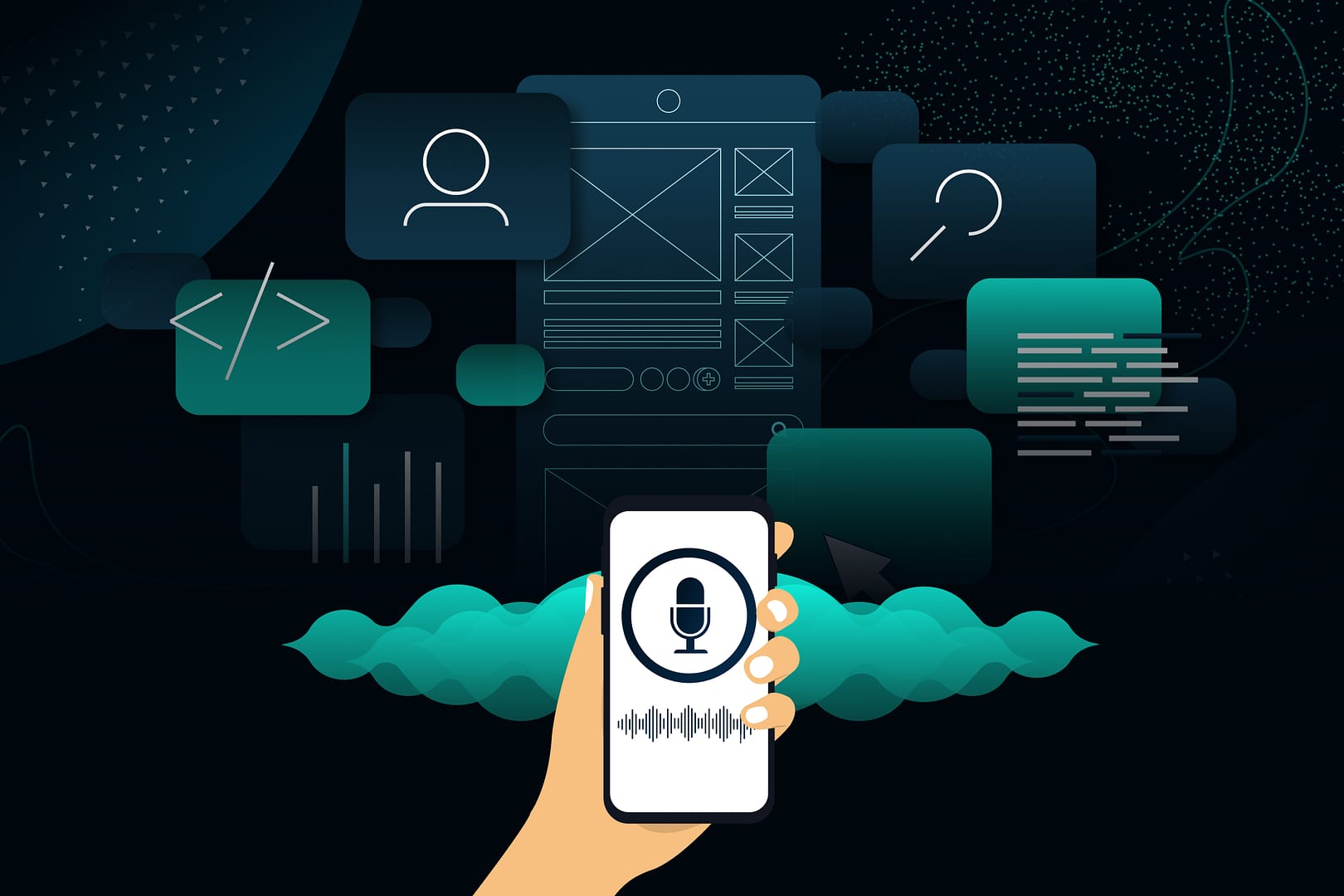UI and UX designers are always looking for new inventive ways to improve the user experience, especially when designing user interfaces. Touchpoints throughout the user interface are significant elements for users. So, improving their accessibility can effectively streamline the product experience.
Incorporating a voice user interface into the UI and UX design is one way to implement this. A VUI collects and recognizes voice input from the user and responds like a human, often through a chat window. VUI is a current hot topic, with leading companies like Amazon, Google, and Apple already integrating it into their products. For example, the Amazon shopping app features voice search, allowing users to find products without typing.
Voice User Interfaces (VUIs) represent an exemplary innovation in design. Moving away from traditional user interface methods, VUIs use speech as the primary means of navigation through digital platforms. Unlike the conventional click-and-tap approach, VUIs allow users to interact with websites and apps using their voices.
VUIs are on the rise because they merge human conversation with digitized communication, enabling natural dialog between users and digital entities. You can incorporate VUI into your product as well. Start with a solid UX strategy, followed by design and implementation.
There are various types of voice user interfaces, many reasons to adopt them, the advantages they offer, and several aspects that contribute to their effectiveness.
Learn more about the effectiveness of voice user interfaces and how to integrate them into your design strategy.
What is a Voice User Interface (VUI)?
A Voice user interface (VUIs) is an interface that enables users to interact with systems through verbal commands i.e. through voice or speech. These act as virtual assistants like Siri, Google Assistant, and Alexa. The main benefit of a VUI is that it offers a hands-free, eyes-free interaction, allowing users to focus their attention elsewhere.
However, it is impractical to apply the same design principles for graphical user interfaces to VUIs. VUIs lack visual cues, so users do not have clear indications of what the interface can do or what their options are. When designing VUI actions, it’s crucial that the system clearly communicates available interaction options, informs users about the functionality they are using, and limits information to what users can easily remember.
People usually associate voice with interpersonal communication rather than interactions with technology, which can lead to uncertainty about the VUI’s capabilities. Therefore, for a VUI to be effective, it must have excellent language comprehension but also educate users on the types of voice commands and interactions that are possible.
Given the complexity of voice interactions, designers must ensure that users have realistic expectations. Simplifying the design helps remind users that an actual two-way “human” conversation is not feasible. User patience in building a communication rapport will enhance satisfaction as the VUI becomes better at recognizing the user’s voice, resulting in more accurate responses.
Understanding the VUI Concept
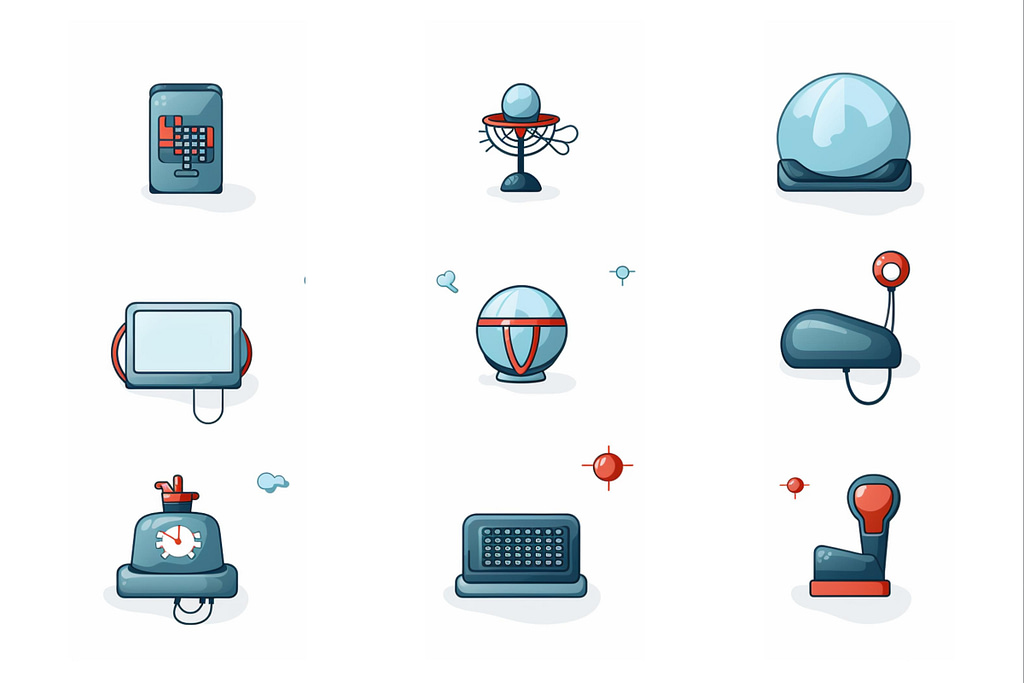
Voice user interfaces (VUIs) represent a continuously evolving design concept. Designers must grasp the essence of VUIs and create effective voice interactions. It is a design approach that is something more than simply incorporating voice commands and adding features or new dialog flows.
To design effective VUIs, UI/UX professionals need to develop a seamless user journey, where the integration of voice commands only further improves the overall user experience.
The core idea of VUI design involves the following:
- Voice recognition via smart devices.
- Enabling users to interact with these devices through natural conversation.
- Making voice interaction both unique and challenging.
Designers should integrate conversational user interfaces within existing graphical interfaces to provide a smooth and familiar experience for users.
How Does Voice User Interface(VUI) Work?
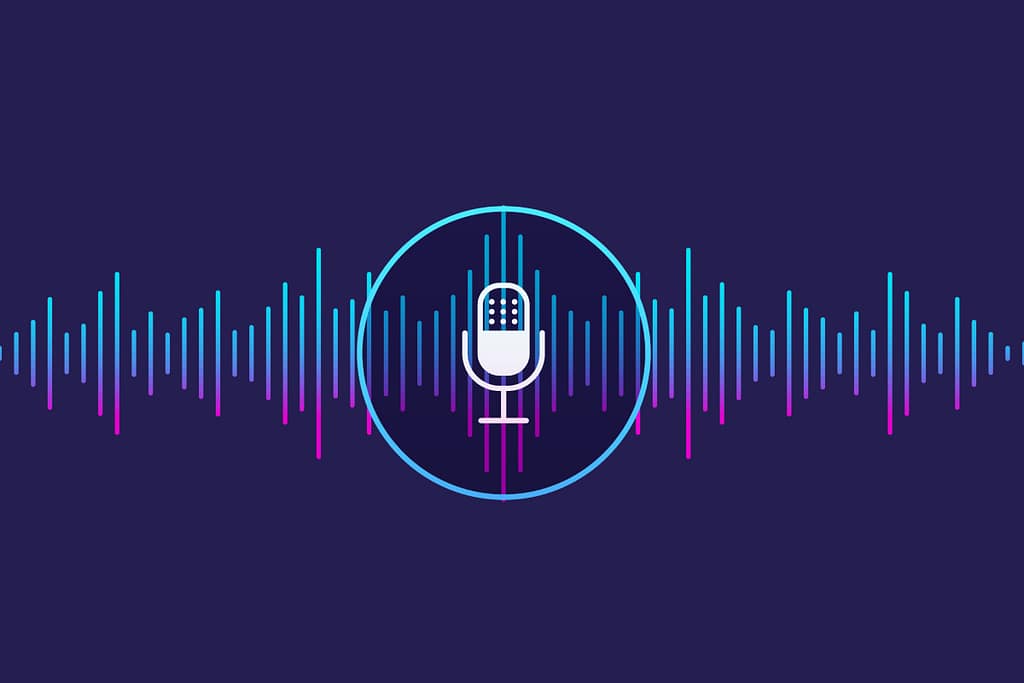
Voice interface design relies on voice commands and speech recognition to create an efficient interaction. This involves a blend of graphical user interfaces and voice recognition software. The effectiveness of a VUI depends on the software’s ability to recognize human speech and extract valuable information from voice commands.
Voice User Interface’s Main Components
The primary components of a VUI mechanism include:
- Speech recognition
- Natural language processing (NLP)
- Speech synthesis
- Feedback
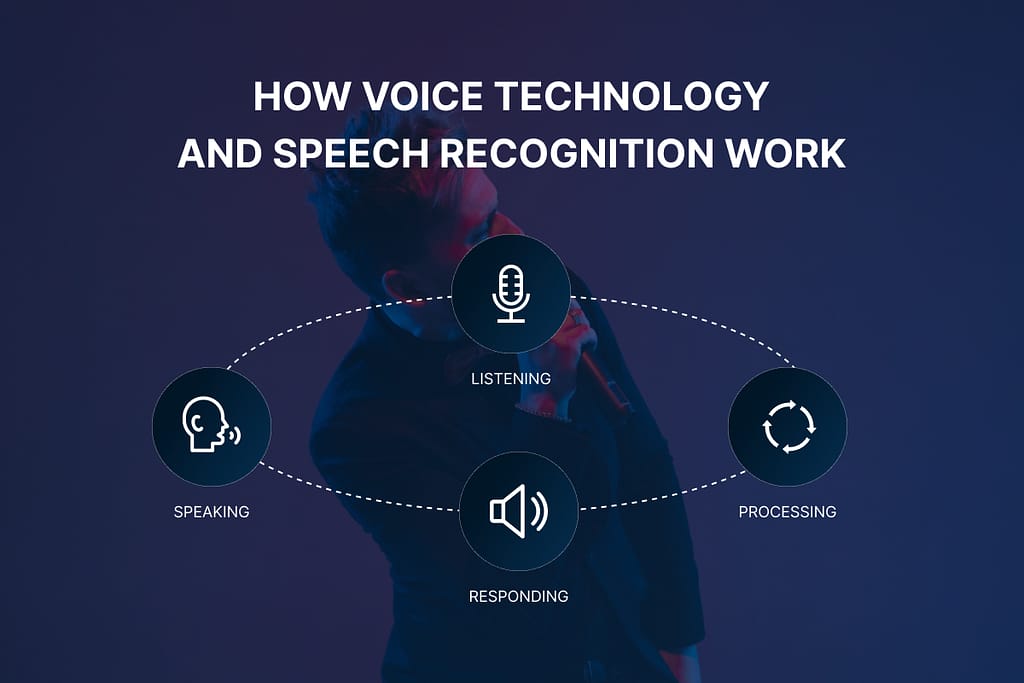
In addition to traditional UI/UX roles, designers must also think like conversation designers. Knowledge of conversational UX design, such as chatbots, can be beneficial. Designers can leverage their expertise in these areas to create engaging voice interactions for a better user experience beyond simple dialog flows.
VUI Design’s Key Elements
Effective VUI design hinges on more than just automatic speech recognition. It must also synthesize natural conversation, understand spoken commands, and transmit messages accurately. The most critical elements of VUI design include:
Automatic Speech Recognition (ASR): Converts spoken language into text.
Natural Language Processing (NLP): Understands and processes the meaning of the text.
Speech Synthesis: Converts text back into spoken language.
User Feedback: Provides users with responses and feedback to guide the interaction.
By carefully implementing these components, designers can ensure a successful and user-friendly voice interface.
Voice User Interface’s Advent

People are gradually moving from traditional interfaces to more user-friendly options like voice search. According to a Google survey, 27% of people are already using voice search on their phones, primarily for asking questions or finding product links. VUIs are effective because they are easier to use on the go compared to typing.
This trend is particularly relevant for e-commerce sites and applications where user search intent is high. As more intuitive products emerge, incorporating VUI-friendly design is essential for enhancing a product’s functionality.
VUIs Importance in Design
Web designers are integrating Voice User Interfaces to improve usability and make websites more accessible, especially for users with disabilities. Here are some reasons to include VUIs in your website:
Natural Interaction: VUIs provide a conversational system that meets users’ needs, promoting high levels of engagement and satisfaction.
Accessibility: Voice interfaces make digital content available to a broader audience, including those with impairments, aligning with principles of inclusion.
Efficiency: Voice commands are often more accessible than typing or clicking, allowing users to perform tasks hands-free, which is beneficial for activities like driving or multitasking.
Technological Advancements: Improvements in natural language processing and speech recognition have made VUI technologies more reliable.
Enhanced User Engagement: VUIs create a more engaging user experience, making users feel more connected to the digital platform.
Increased Efficiency: Using voice commands streamlines tasks, reducing the time and resources needed to operate a website, thus increasing user satisfaction.
Innovation and Differentiation: VUIs set a site apart, showing a commitment to technological advances and user-friendliness.
What is the Difference Between UI and UX Design for GUI and VUI?

Traditionally, UI and UX design involves creating user journeys through graphical interfaces such as search bars. However, can VUI design be approached in the same manner as GUI design?
No. Incorporating VUI into UI/UX design may appear similar but is significantly different from GUI design.
In contrast to GUI design, UI and UX designers must design user journeys that are entirely touch-free and vision-free.
The search intent and user persona may be similar for both interfaces, and the scope, pain points, and end goals of users will also be consistent.
However, the user journey mapping differs; the navigation from voice search to achieving the end goal is distinct.
In a graphical user interface, every interaction with the product is visually guided. There are plenty of available options on the interface that can assist users in seeing and feeling what is necessary to arrive at a decision.
Conversely, the journey for the voice UI is entirely touchless. Users may not even look at the screen while giving inputs. Therefore, it is crucial to focus on voice user interface design. Users may also need time to understand the complex capabilities of the system persona (the VUI tech stack). Thus, it is the designer’s responsibility to communicate what users can accomplish through the VUI widget.
Additionally, the user’s search intent remains consistent regardless of the interface. However, their expectations for the system’s response differ. For instance, when using a voice user interface, they expect an interaction similar to human interaction with a system designed to assist like a human.
All these factors together make VUI design more challenging.
How to design a Voice Interface?
This is a four-step process for UI and UX designers to follow when designing a voice user interface experience for a specific persona.
Determining Scope and Requirements
The end goal must be defined at the project’s outset to determine if the voice search enhances the experience. Once this is clear, develop an understanding of how voice search interfaces work. Use applications, view sample VUI journey maps, talk to VUI professionals, and read relevant journals about NLP (natural language processing) to create the best UX outcome.
Hands-on experience is invaluable. Use voice-control apps like Amazon’s Alexa to understand interactions with a tech persona, which is vastly different from real-time human interaction. Focus on the design aspects to enhance your design thinking process. Observe the visual elements that act as cues and guide the user to the next step.
Start Mapping the User Journey

Define user personas, their pain points, and end goals. Then, design the user journey mapping from the starting point to the endpoint where they achieve their goal.
When starting with VUI design, focus on one element where a voice UI can be more helpful. Then, map the customer journey for this specific scenario.
Design the Prototype

Use chatbot-building tools like Voiceflow to design the user flow. This includes adding prompts, responses, follow-ups, and interlinking connections between the flow. Create a low-fidelity storyboard or a fully functional prototype to demonstrate how the VUI works.
Focus on ensuring the user experiences a natural conversational flow even when interacting with a non-human element. Include proactive elements to bridge the gap between human-tech conversations for a smooth experience.
Use positive and refined language in the prompts. For example, use ‘Are you looking for coats for special occasions?’ instead of ‘Sorry. I can’t understand you.’
Validation and Testing
After designing the layout, test it with multiple scenarios to identify discrepancies. This will help refine the VUI user journey and prevent user drop-outs. This iterative process will continue even after VUI development. Conduct mock user tests to assess the functionality and seamlessness of the experience in relation to the end goal.
How can Voice User Interface be Integrated?
The process of Voice User Interfaces includes several stages:
Speech Input: The system uses the users voice commands and queries to interact with them.
Speech Recognition: This stage involves advanced computations to convert speech to text, often referred to as speech recognition.
Intent Recognition: The system then takes the information in the text and determines what the user wants, whether it’s a specific action or particular information.
Action Execution: Upon confirmation, the system processes the intended action, such as fetching data or performing an operation.
Feedback: The system responds to the user’s actions and asks for confirmation if the intention is unclear.
The Challenges Voice User Interface in UI and UX Design Faces
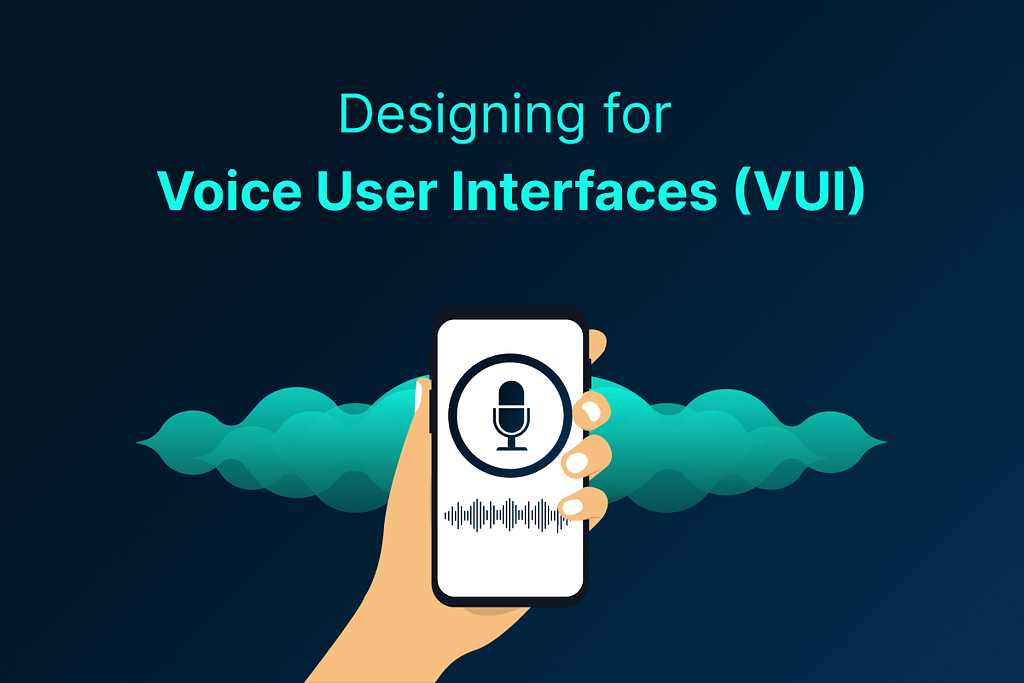
When implementing Voice User Interfaces, it’s essential to be aware of potential challenges:
Overcomplicating Commands: Avoid creating intricate and lengthy voice commands. The system should be designed for interaction with simple and easy-to-use sentences.
Lack of Clarity in Prompts: Users may not follow directions if they are unclear. Ensure that questions are precise and leave no doubt about what is expected.
Ignoring Context: Misunderstanding context can disrupt conversational VUIs. The system should be aware of the context in which the conversation is taking place for smooth interaction.
Inadequate Testing: Limited testing options for VUIs can lead to incorrect speech interpretation or wrong assumptions about user intentions. Rigorous testing is necessary to ensure system reliability.
Voice User Interface’s Future in Web Design
Looking ahead, Voice User Interfaces (VUIs) will transform web design and lead to a new model for interacting with digital content. Several trends and developments highlight the promising prospects of integrating VUIs into web design:
Advancements in Natural Language Processing (NLP): As NLP algorithms become more sophisticated, they will better grasp user intentions and context, allowing for more natural communications with digital interfaces.
Multimodal Interfaces: Voice will continue to be combined with actions like gestures or images.
Personalization and User Context: Future VUIs will provide highly customized interactions, using customer information and artificial intelligence to learn preferences from previous experiences and offer relevant responses in future encounters.
Integration with IoT Devices: Voice commands will be the preferred mode of control for smart homes, IoT-equipped cars, and other interconnected objects used in daily activities.
Enhanced Security Measures: With the growing popularity of voice interactions, securing user information will be a significant concern.
Industry-Specific Applications: VUI applications will increase in industry-specific situations. For example, in healthcare, voice interfaces can allow hands-free access to patient records, which is crucial in emergencies.
Cross-Platform Integration: A unified voice across websites, mobile applications, and smart home systems will create a connected digital world for users.
Ethical Considerations and Regulation: The rise of VUIs raises concerns about data privacy, informed consent, and the ethical use of AI.
Summary
The emergence of Voice User Interfaces marks a significant step forward in usability, enhancing understanding between users and computers. As technology advances, voice user interfaces could become a standard part of websites or app interfaces, changing how people interact with these devices. If companies integrate Voice User Interfaces into UI and UX design, they will remain innovative and witness an increase in customer interaction inclusiveness. By focusing on essential considerations and best practices, the inclusion of VUIs can lead to a more user-friendly and inclusive eCommerce environment. Voice user interfaces are expected to be central to the new generation of human-machine interaction, moving us closer to a smoother and more natural digital dialogue.
Finding it challenging to integrate VUI in your UI and UX design? Contact Wilson Wings, one of the best UI/UX agencies in Bangalore, and let our team of design experts handle it for you. We offer comprehensive UI/UX design services from UX audit to testing and have worked with clients across various industries. With extensive experience and a talented team, we can elevate your product’s design and user experience. Read our successful customer stories here.

